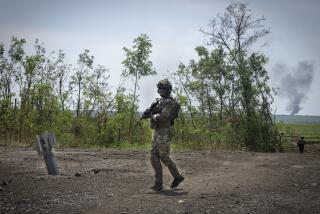Allies Hope to Exploit Iraqi Lack of Mobility : Ground war: The strategy would be to strike the enemy fast and hard--and keep the battle moving.
- Share via
EASTERN SAUDI ARABIA — U.S. and allied commanders are laying the final plans for a ground war that will rely on speed and unprecedented violence to punch through Iraq’s fortified lines and exploit Saddam Hussein’s inability to adjust his fixed positions to the flow of battle.
Final preparations for the assault will be examined this weekend when Defense Secretary Dick Cheney and Gen. Colin L. Powell, chairman of the Joint Chiefs of Staff, meet in the Saudi capital of Riyadh with top U.S. commanders. But the framework for the offensive--and plans to deal with Hussein’s formidable defenses--have been in place for weeks.
According to commanders at the front, the scope of the operation will be so large that entire corps will be moving across the battlefield simultaneously, supported by massive, close-in air support.
“We haven’t seen elements of that size maneuvering since the North African campaign in World War II,” said Col. Leroy Goff, a brigade commander with the Army’s 3rd Armored Division.
The 3rd Armored sped across France and into Germany during that war, sometimes covering as much as 100 miles a day, as the vanguard for Gen. George S. Patton’s attacking forces. No one expects it to match that feat in attempting to engage and destroy Iraq’s estimable Republican Guard, but commanders say that maintaining momentum is essential even though Iraq has three elements that could slow the drive--mines, artillery and chemical weapons.
“We have to keep going forward. Don’t get bogged down. Don’t stop,” said Col. Dana Robertson, who heads the division’s engineering battalion, which would be called on to breach the antitank and antipersonnel minefields with a variety of devices, including explosive charges, tanks with rakes and rollers and grappling hooks thrown by point men into a minefield in the hopes of triggering the devices.
The mines, hastily laid in the weeks before the war began, are capable of blowing a 60-ton M-1A1 tank six feet into the air. Others will withstand the shock of exploding artillery rounds, fired by the allies in attempts to clear a minefield, but will be touched off by the longer-lasting pressure exerted by a tank. Also buried in the sand are antipersonnel mines designed to maim.
But the attacking force, backed by Apache helicopters and antitank missiles and artillery, has the option of avoiding a frontal assault by sweeping around the Iraqis’ flanks.
“What you want to do is present him (the enemy) several ways that he can go and any way he chooses will kill him,” said Col. Charles Burke, who leads the 3rd Armored Division’s aviation brigade. “It’s just like being in the boxing ring. If you can knock him off balance, then you hit him a few more times, he’ll go down.
“I think in the first couple of waves, he’ll put up everything he’s got. But I don’t know how long he can sustain it. The U.S. Army can fly at night better than any other force in the world.”
Commanders believe that Iraq’s first response to an attack will be the massive use of artillery, which traditionally causes more casualties than any other weapon. Iraq has more than 1,000 Soviet and South African artillery pieces, many of them long-range. “We’re overwhelmed by their numbers, but we’re not necessarily impressed by their accuracy,” said Col. John Michitsch, commander of the division’s artillery.
Michitsch said Iraq’s artillery is deeply dug into sand fortifications and thus does not have the mobility to react to allied attacks at unexpected locations. If the allies can penetrate the Iraqi lines and keep the battle moving, the Iraqis would lose considerable time trying to shift and re-aim their guns, he said.
The big advantage of American artillery is its accuracy. Using the military’s satellite-linked global positioning system, gunners and forward observers with laser range-finders can plot and strike targets with precision, rather than having to “bracket” and “zero in” as they did in earlier wars.
The United States also has two new field radar systems, the Q-36 and Q-37, which use computers to track incoming rounds and pinpoint the location of the enemy batteries that fired them.
“The desert suits the 3rd Armored Division, and so does fighting in it,” said Maj. Gen. Paul Funk, the division commander. “If we’re going to do it anywhere, we’re suited for this place.”
This article was written in part from correspondent pool reports cleared by U.S. military authorities.
U.S. ARMY’S THREE-DIMENSIONAL ATTACK
The U.S. Army’s “AirLand Battle” concept has three dimensions: close combat, deep operations and rear-area security.
Airborne paratroopers drop deep behind enemy lines, supported by helicopters and ground attack planes. Land Assault: Army task force attacks enemy front-line defenses Allied rear area: Allied reserve units Close combat area: Enemy trenches, mines and bunkers Deep enemy area: Enemy reserve infantry and tanks Tenets of “AirLand Battle”: Initiative: make the enemy react to U.S. forces Depth: Includes concepts of time, distance and resources Agility: Ability to act and react faster than the enemy Synchronization: Coordination with all higher and lower echelons, other services and allies.
Source: U.S. Department of Defense: Modem Land Combat by David Miller and Christopher F. Foss
More to Read
Sign up for Essential California
The most important California stories and recommendations in your inbox every morning.
You may occasionally receive promotional content from the Los Angeles Times.










